
Matsutake, Tricholoma matsutake, is a species of choice edible mycorrhizal mushroom that grows in East Asia, northern Europe, and North America. It is prized in Japanese cuisine for its distinct spicy-aromatic odor.

Tricholoma is a genus of fungus that contains many fairly fleshy white-spored gilled mushrooms which are found worldwide generally growing in woodlands. These are ectomycorrhizal fungi, existing in a symbiotic relationship with various species of coniferous or broad-leaved trees. The generic name derives from Ancient Greek: τριχο-, romanized: tricho-, lit. 'hair' and Ancient Greek: λῶμα, romanized: loma, lit. 'fringe, border' although only a few species have shaggy caps which fit this description.

Tricholoma equestre or Tricholoma flavovirens, commonly known as the man on horseback or yellow knight is a widely eaten but arguably toxic fungus of the genus Tricholoma that forms ectomycorrhiza with pine trees.
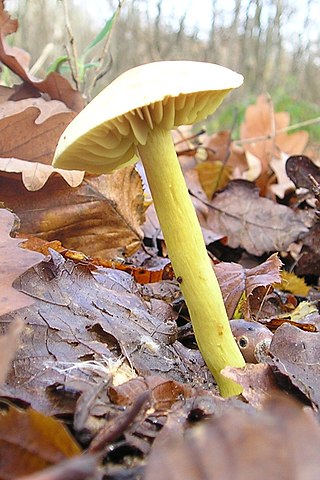
Tricholoma sulphureum, also known as the stinker, sulphur knight or gas agaric, is an inedible or mildly poisonous mushroom found in woodlands in Europe. It has a distinctive bright yellow colour and an unusual smell likened to coal gas. It occurs in deciduous woodlands in Europe from spring to autumn.

Tricholoma magnivelare, commonly known as the matsutake, white matsutake, ponderosa mushroom, pine mushroom, or American matsutake, is a gilled mushroom found East of the Rocky Mountains in North America growing in coniferous woodland. These ectomycorrhizal fungi are typically edible species that exist in a symbiotic relationship with various species of pine, commonly jack pine. They belong to the genus Tricholoma, which includes the closely related East Asian songi or matsutake as well as the Western matsutake and Meso-American matsutake.

Tricholoma saponaceum, also known as the soap-scented toadstool, soapy tricholoma, soapy knight or soap tricholoma is an inedible mushroom found in woodlands in Europe and North America.
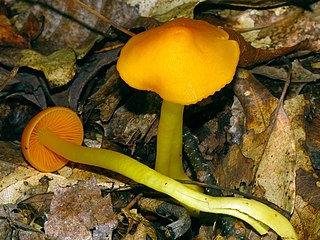
Humidicutis marginata is a gilled fungus of the waxcap family.

Tricholoma columbetta, commonly known as dove-coloured tricholoma, is an edible mushroom of the large genus Tricholoma. It is found in Europe, where it is eaten in France.
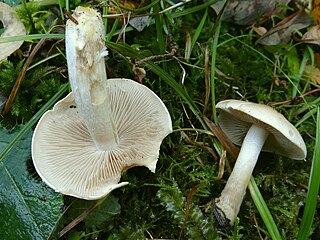
Tricholoma album, commonly known as the white knight, is an all-white mushroom of the large genus Tricholoma. It is found in Europe, India, and possibly North America. The cap and gills are white. The whitish stipe has no ring.

Tricholoma ustale, commonly known as the burnt knight, is a species of mushroom in the large genus Tricholoma. It is found in Asia, Europe, and North America, though those from North America may represent one or more different species.
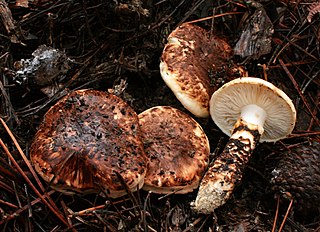
Tricholoma caligatum is a mushroom of the agaric genus Tricholoma. It is a large species with a distinct sheathing ring on the stem, found in mycorrhizal association with various trees throughout the Mediterranean. It is sometimes referred to as the European Matsutake, though it is certainly gastronomically inferior to the true Matsutake, a related species highly prized in Japan.

Tricholoma davisiae is a mushroom of the agaric genus Tricholoma. It was first formally described by Charles Horton Peck in 1900.

Tricholoma fumosoluteum is a mushroom of the agaric genus Tricholoma. First described by Charles Horton Peck in 1875 as Agaricus fumosoluteus, it was transferred to the genus Tricholoma by Pier Andrea Saccardo in 1887.

Tricholoma niveipes is a mushroom of the agaric genus Tricholoma. It was formally described as new to science by American mycologist Charles Horton Peck in 1901.
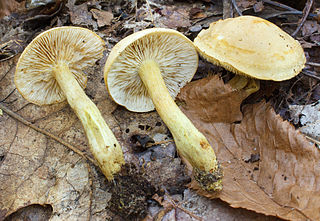
Tricholoma odorum is a mushroom of the agaric genus Tricholoma. It was formally described in 1898 by American mycologist Charles Horton Peck. It is considered inedible.
Tricholoma acre is a mushroom of the agaric genus Tricholoma. The fruit bodies have light gray caps and stems, light grey gills, and an acrid taste.

Tricholoma subluteum is a mushroom of the agaric genus Tricholoma. Found in North America, it was described in 1904 by Charles Horton Peck.

Tricholoma sejunctum is a mushroom that appears across much of the Northern Hemisphere and is associated with pine forests.

















